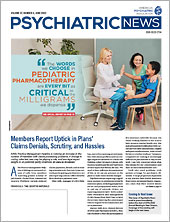Physicians are reporting a global increase in the number of young people with functional tic-like behaviors, with symptoms that are severe, frequent, and highly disabling. The numbers have increased markedly during the past two years of the COVID-19 pandemic.
The tic-like behaviors come on rapidly and have been strikingly similar, and individuals have only a limited ability to suppress them, according to an article by Tamara Pringsheim, M.D., and colleagues. They published their findings from eight tourette syndrome clinics in five countries in the December 2021 Movement Disorders. Before the pandemic, referrals for functional tic-like behaviors as a primary problem accounted for only about 1% to 2% of caseloads, but now account for up to 35%.
What’s driving this increase? Researchers found that all patients developed their symptoms after watching influencers on social media, primarily TikTok and YouTube, with tics or Tourette syndrome. The pages are wildly popular: On TikTok alone, #tourettes had racked up 5.2 billion views by press time. These patients share other similarities: They were more than four times as likely to have an anxiety disorder and five times as likely to have a depressive disorder as those with primary tic disorders.
“The magnitude of functional disability and level of parental distress caused by the tic-like behaviors are extreme,” the authors wrote. They included large amplitude arm movements, hitting and punching self or family members, and blurting out obscenities or bizarre words or phrases. One teenager on YouTube, whose condition appeared abruptly 16 months ago, likened her symptoms to what happens “if you shake a can of [soda] and open the tab.”
“Functional tic-like behaviors have always been around, like other functional movement disorders, but until recently they were not common in clinical practice,” Alexander Münchau, M.D., professor and director of the Institute of Systems Motor Science in Lübeck, Germany, told Psychiatric News. He is a co-author of an article on the phenomena also published in the December 2021 Movement Disorders. “We know that this subconscious, automatic picking up of movements from others is not uncommon and has been referred to as echo-phenomena.”
Münchau pointed to similar “outbreaks” of functional movement disorders within communities, such as “jumping Frenchmen of Maine” syndrome, characterized by an extreme startle reaction and echolalia. It caught on among lumberjacks in a logging camp in the 19th century. “This usually happens when people meet others face to face. What is new is that such echo-phenomena can also occur through social media, without personal contact,” he added.
Tammy Hedderly, M.D., an acute pediatric neurologist who specializes in movement disorders at the Evelina London Children’s Hospital, told Psychiatric News that the brains of people affected are often highly suggestible. “Watching tics on social media may therefore be a perpetuating factor that makes symptoms worse.” Factors such as social isolation, pandemic stressors, and loss of routine in relation to the pandemic is also playing a role. “I was surprised at how many children and young adolescents were also engaging in self harm and the percentage that reported suicidality, which demonstrates the level of distress the children and families are experiencing,” she added.
Screen Time Affecting Mental Health
Adolescents’ screen time has skyrocketed during the pandemic, and now amounts to a whopping 7.7 hours a day, according to research by Jason Nagata, M.D., M.Sc., and colleagues, published by JAMA Pediatrics on November 1, 2021. This includes 2.4 hours a day streaming videos, 1 hour a day on social media, and nearly an hour of internet browsing. A slew of studies implicates smartphone and social media use in the increase in mental distress, body image issues, self-injurious behavior, and suicidality among young people.
“We make body image issues worse for 1 in 3 teen girls” was the summation of internal company research leaked by a former employee at Meta Platforms Inc., formerly called Facebook, about its own Instagram app. A nationwide coalition of state attorneys general is investigating Meta Platforms Inc. and the techniques it uses to boost young users’ engagement with Instagram and the resulting harms.
A study by Sarah Coyne, Ph.D., and colleagues published February 2, 2021, in the Journal of Youth and Adolescence found that particularly for girls, a high level of social media, television, or video game use that increased over time was most predictive of suicide risk in young adulthood. That study followed 500 adolescents who ranged in age from 12 to 15 at baseline over 10 years to examine the link between various types of screen time to suicide risk in emerging adulthood.
Paula Durlofsky, Ph.D., a psychologist in private practice in Bryn Mawr, Pa., told Psychiatric News the problems associated with teens’ screen time “really underscore the power that social media has to shape young minds, minds that are still developing and so vulnerable and impressionable.” She advises clinicians to routinely ask patients about their social media and technology use during initial consultations and how they think it’s affecting them. “Keep in mind that social media use may be a factor in their condition.”
Durlofsky, who is the author of Logged In and Stressed Out: How Social Media Is Affecting Your Mental Health and What You Can Do About It, said she wrote her book to address concerns expressed by many of her patients, including that their social media use was causing their depression and anxiety and that they were using it to self-medicate or cope with dysfunctional relationships. “Parents need to be aware of what their young kids are watching and informed about the research findings on social media and its potential dangers. We need to work to control and manage our screen time and that of young people.”
What’s her biggest concern? “Teens are not developing interests or finding ways to use the other parts of their brains or minds beyond social media,” Durlofsky said. “Spending hours in front of a screen is going to negatively affect our mental health because it narrows our experiences and our world. It definitely steals our precious time away from activities and pursuits that nourish our bodies and minds, such as exercising, connecting with nature, pursuing creative outlets, and nurturing our relationships with the people we care most about.”
Durlofsky advises adults and teens alike to “give themselves permission to step away from technology, including all screens. That is an act of self-love and self-protection. Take a break and commit to nondigital self-care practices, anything that creates a feeling of ‘flow.’ ”
Tourette Syndrome or Tics?
For physicians who haven’t seen many cases, Münchau said that distinguishing functional tic-like behaviors after social media (TLB-SM) from Tourette syndrome (TS) can be challenging. He said he has seen many patients who were misdiagnosed with TS who have “had to go through a difficult re-diagnosing and acceptance process.” However, several clear-cut differences have emerged: age of onset (5 years on average with TS vs. 15 years with TLB-SM); symptom onset (over months or years with TS vs. hours or days with TLB-SM). Boys are diagnosed with TS at four times the rate of girls, whereas most adolescents afflicted with TLB-SM are girls.
The movements themselves are different, too: TS is characterized by abnormal simple motor movements often involving the head, face, and neck. In TLB-SM, abnormal movements typically involve the trunk and extremities, are complex and variable, and worsen over time and in the presence of others. The movements also decline when patients were alone and tended to be “goal-directed,” or directed toward others, such as slapping caregivers.
Mainstays of treatment for TS are antipsychotic medication and cognitive-behavioral therapy. However, for TLB-SM, “management includes psychoeducation about functional symptoms and tic-like attacks. This explanation in itself can result in a dramatic resolution of symptoms. It is important to note that these young people show little or no response to the usual medications for tics, and we would not recommend prescription,” wrote Hedderly and colleagues in the May 21, 2021, Archives of Disease in Childhood. ■

